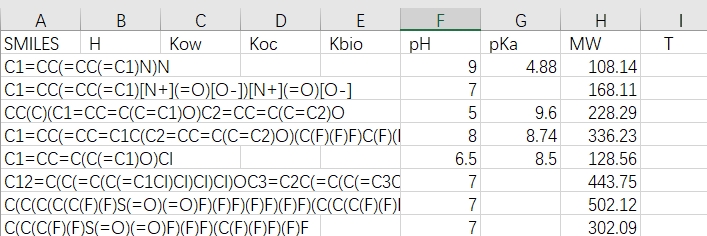Property Prediction
The Henry's law constant (H), octanol-water partition coefficient (Kow), water solubility (WS), and soil adsorption coefficient (Koc), for the given SMILES will be calculated sequentially (measured in log units), and the respective units are Pa·m³/mol, dimensionless, mol/L and L/kg, respectively. The biodegradation rate is simply predicted as biodegradable (B) and non biodegradable (NB), with median values of 0 and 1 for removal rate prediction, respectively. Similarly, when selecting acute fish toxicity as the predicted object, the LC50 values (mol/L, measured in -log units) of fathead minnow will be given. It represents the concentration at which 50% of the test organisms remain within a 96 hour period, was used to describe the biological toxicity of chemicals. For the prediction of the second-order chlorine (Cl) reaction rate constant with organic compounds, we categorize the rate into three levels: fast (>100 M⁻¹s⁻¹), medium (1-100 M⁻¹s⁻¹), and slow (<1 M⁻¹s⁻¹). 'IN' and 'OUT' represents being within and beyond the application domain respectively, which indicates the reliability of the prediction.
Removability of Sewage Plant Prediction
Based on the nine-box model, the chemical environmental distribution after treatment in regular wastewater treatment plants was predicted. The detailed process can refer to the official documentation of SimpleTreat. We provide 36 variable parameters for the impact removal process. For more information, please refer to the input examples. Their meanings, default values, units, and formulas can be found in the help document. The minimum input metric for the model is the SMILES of the chemical, while all other variables use default and predicted values.The most significant uncertainty in removal rate estimation typically stems from biodegradability (expressed in h⁻¹). Furnishing reliable biodegradability data can substantially enhance the precision of predictive models.

